Vehicle frame
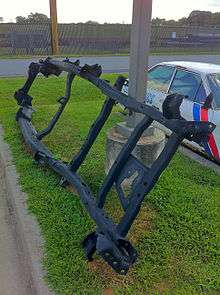
_(03).jpg)
A vehicle frame is the main supporting structure of a motor vehicle to which all other components are attached, comparable to the skeleton of an organism.
Until the 1930s, virtually every car had a structural frame, separate from its body. This construction design is known as body-on-frame. Over time, nearly all passenger cars have migrated to unibody construction, meaning their chassis and bodywork have been integrated into one another.
Nearly all trucks, buses, and most pickups continue to use a separate frame as their chassis.
Functions
The main functions of a frame in motor vehicles are:[1]
- To support the vehicle's mechanical components and body
- To deal with static and dynamic loads, without undue deflection or distortion.
- These include:
- Weight of the body, passengers, and cargo loads.
- Vertical and torsional twisting transmitted by going over uneven surfaces.
- Transverse lateral forces caused by road conditions, side wind, and steering the vehicle.
- Torque from the engine and transmission.
- Longitudinal tensile forces from starting and acceleration, as well as compression from braking.
- Sudden impacts from collisions.
Types of frame according to the construction:
- Ladder type frame
- X-Type frame
- Off set frame
- Off set with cross member frame
- Perimeter Frame
Frame rails

Typically the material used to construct vehicle chassis and frames is carbon steel; or aluminum alloys to achieve a more light-weight construction. In the case of a separate chassis, the frame is made up of structural elements called the rails or beams. These are ordinarily made of steel channel sections, made by folding, rolling or pressing steel plate.
There are three main designs for these. If the material is folded twice, an open-ended cross-section, either C-shaped or hat-shaped (U-shaped) results. "Boxed" frames contain chassis rails that are closed, either by somehow welding them up, or by using premanufactured metal tubing
C-shape
By far the most common, the C-channel rail has been used on nearly every type of vehicle at one time or another. It is made by taking a flat piece of steel (usually ranging in thickness from 1/8" to 3/16") and rolling both sides over to form a c-shaped beam running the length of the vehicle.
Hat
Hat frames resemble a "U" and may be either right-side-up or inverted with the open area facing down. Not commonly used due to weakness and a propensity to rust, however they can be found on 1936–1954 Chevrolet cars and some Studebakers.
.jpg)
Abandoned for a while, the hat frame gained popularity again when companies started welding it to the bottom of unibody cars, in effect creating a boxed frame.
Boxed
Originally, boxed frames were made by welding two matching C-rails together to form a rectangular tube. Modern techniques, however, use a process similar to making C-rails in that a piece of steel is bent into four sides and then welded where both ends meet.
In the 1960s, the boxed frames of conventional American cars were spot-welded here and there down the seam; when turned into NASCAR "stock car" racers, the box was continuously welded from end to end for extra strength.
Design features
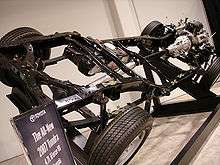
While appearing at first glance as a simple form made of metal, frames encounter great amounts of stress and are built accordingly. The first issue addressed is beam height, or the height of the vertical side of a frame. The taller the frame, the better it is able to resist vertical flex when force is applied to the top of the frame. This is the reason semi-trucks have taller frame rails than other vehicles instead of just being thicker.
As looks, ride quality, and handling became more important to consumers, new shapes were incorporated into frames. The most visible of these are arches and kick-ups. Instead of running straight over both axles, arched frames sit lower—roughly level with their axles—and curve up over the axles and then back down on the other side for bumper placement. Kick-ups do the same thing, but don't curve down on the other side, and are more common on front ends.
Another feature seen are tapered rails that narrow vertically and/or horizontally in front of a vehicle's cabin. This is done mainly on trucks to save weight and slightly increase room for the engine since the front of the vehicle does not bear as much of a load as the back. Design developments include frames that use more than one shape in the same frame rail. For example, some pickup trucks have a boxed frame in front of the cab, shorter, narrower rails underneath the cab, and regular C-rails under the bed.
On perimeter frames, the areas where the rails connect from front to center and center to rear are weak compared to regular frames, so that section is boxed in, creating what is known as torque boxes.
Types
Ladder frame
.jpg)
So named for its resemblance to a ladder, the ladder frame is one of the simplest and oldest of all designs. It consists of two symmetrical beams, rails, or channels running the length of the vehicle, and several transverse cross-members connecting them. Originally seen on almost all vehicles, the ladder frame was gradually phased out on cars in favor of perimeter frames and unitized body construction. It is now seen mainly on trucks. This design offers good beam resistance because of its continuous rails from front to rear, but poor resistance to torsion or warping if simple, perpendicular cross-members are used. Also, the vehicle's overall height will be greater due to the floor pan sitting above the frame instead of inside it.
Unibody
The term unibody or unit body is short for unitized body, or alternatively unitary construction design. This engineering approach of a vehicle describes "of a vehicle, a one-piece frame and body structure"[2] A "type of body/frame construction in which the body of the vehicle, its floor plan and chassis form a single structure. Such a design is generally lighter and more rigid than a vehicle having a separate body and frame."[3] Traditional body-on-frame architectures has shifted to the lighter unitized body structure that is now used on most cars.[4] The last UK mass-produced car with a separate chassis was the Triumph Herald, which was discontinued in 1971.
Integral frame and body construction requires more than simply welding an unstressed body to a conventional frame. In a fully integrated body structure, the entire car is a load-carrying unit that handles all the loads experienced by the vehicle—forces from driving as well as cargo loads. Integral-type bodies for wheeled vehicles are typically manufactured by welding preformed metal panels and other components together, by forming or casting whole sections as one piece, or by a combination of these techniques. Although this is sometimes also referred to as a monocoque structure, because the car's outer skin and panels are made load-bearing, there are also still ribs, bulkheads and box sections to reinforce the body, making the description semi-monocoque more appropriate.
The first attempt to develop such a design technique was on the 1922 Lancia Lambda to provide structural stiffness and a lower body height for its torpedo car body.[5] The Lambda though its open layout, with unstressed roof, made it less a monocoque shell and more a bowl - 11,000 were produced.[6]
A key role in developing the unitary body was played by the American firm the Budd Company (now ThyssenKrupp Budd).[6] Budd supplied pressed-steel bodywork, fitted to separate frames, to automakers Dodge, Ford, Buick, and the French company, Citroën. In 1930, Joseph Ledwinka, an engineer with Budd, designed an automobile prototype with full unitary construction.[7]
.jpg)
Citroën purchased this fully unitary body design for the Citroën Traction Avant. This high volume, mass production car was introduced in 1934 and sold 760,000 units over the next 23 years of production.[6] This application was the first iteration of the modern structural integration of body and chassis, using spot welded deep stamped steel sheets into a structural cage, including sills, pillars and roof beams.[5] In addition to a unitary body with no separate frame, this vehicle also featured other novelties such as four-wheel independent suspension, and front-wheel drive. As a result of these innovations, the Traction Avant had a low-slung appearance futuristic for its era.[8]
For the Chrysler Airflow (1934–1937). Budd supplied a variation - three main sections from which the Airflow's body was welded into what Chrysler called a bridge-truss construction. For the Chrysler Airflow unfortunately, this method was not ideal - panel fits were poor.[6] To convince a skeptical public of the strength of unibody both Citroën and Chrysler created advertising films showing cars surviving after being pushed off a cliff.[6]

The streamlined 1936 Lincoln-Zephyr with conventional front-engine, rear-wheel-drive layout utilized a unibody structure.[9] By 1941, unit construction was no longer a new idea for cars, "but it was unheard of in the [American] low-price field [and] Nash wanted a bigger share of that market."[10][11] The single unit body construction of the Nash 600 provided weight savings and Nash's Chairman and CEO, George W. Mason was convinced "that unibody was the wave of the future."[12][13]
Since then more cars were redesigned to the unibody structure, which is now "considered standard in the industry".[13] By 1960, unitized body design was used by Detroit's Big Three on their compact cars (Ford Falcon, Plymouth Valiant, and Chevrolet Corvair). After Nash merged with Hudson Motors to form American Motors, its Rambler-badged automobiles continued exclusively building variations of the unibody.
Although the 1934 Chrysler Airflow had a weaker than usual frame and body framework welded to the chassis to provide stiffness, in 1960, Chrysler moved from body-on-frame construction to a unit-body design for most of its cars.[14]

Most of the American-manufactured unibody automobiles used torque boxes in their vehicle design to reduce vibrations and chassis flex, with the exception of the Chevy II which had a bolt-on front apron (erroneously referred to as a subframe).[15] American Motors (with its partner Renault) during the late-1970s incorporated unibody construction when designing the Jeep Cherokee (XJ) platform using the manufacturing principles (unisides, floorpan with integrated frame rails and crumple zones, and roof panel) used in its passenger cars, such as the Hornets and all-wheel-drive Eagles for a new type of frame called the "Uniframe ... a robust stamped steel frame welded to a strong unit-body structure, giving the strength of a conventional heavy frame with the weight advantages of Unibody construction."[16] This design was also used with the XJC concept developed by American Motors prior to its absorption by Chrysler, which later became the Jeep Grand Cherokee (ZJ). —including modern day sport utility vehicles (Jeep Grand Cherokee et al.).
The unibody is now the preferred construction for mass market automobiles and crossovers. This design provides weight savings, improved space utilisation, and ease of manufacture. Acceptance grew dramatically in the wake of the two energy crises of the 1970s and the 2000s where compact SUVs using a truck platform (primarily the USA market) were subjected to CAFE standards after 2005 (by the late-2000s truck-based compact SUVs were phased out and replaced with crossovers). An additional advantage of a strong-bodied car lies in the improved crash protection for its passengers.
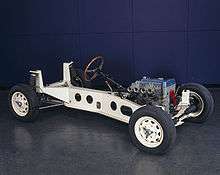
Backbone tube
A backbone chassis is a type of automobile construction chassis that is similar to the body-on-frame design. Instead of a two-dimensional ladder type structure, it consists of a strong tubular backbone (usually rectangular in cross section) that connects the front and rear suspension attachment areas. A body is then placed on this structure.
X-frame
.jpg)
This is the design used for the full-size American models of General Motors in the late 1950s and early 1960s in which the rails from alongside the engine seemed to cross in the passenger compartment, each continuing to the opposite end of the crossmember at the extreme rear of the vehicle. It was specifically chosen to decrease the overall height of the vehicles regardless of the increase in the size of the transmission and propeller shaft humps, since each row had to cover frame rails as well. Several models had the differential located not by the customary bar between axle and frame, but by a ball joint atop the differential connected to a socket in a wishbone hinged onto a crossmember of the frame.
The X-frame was claimed to improve on previous designs, but it lacked side rails and thus did not provide adequate side-impact and collision protection.[17] This design was replaced by perimeter frames.
Perimeter frame
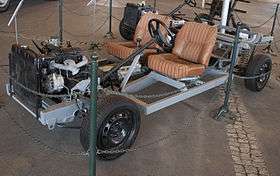
Similar to a ladder frame, but the middle sections of the frame rails sit outboard of the front and rear rails just behind the rocker / sill panels. This was done to allow for a lower floor pan, especially at the passenger footwells, to lower the passengers' seating height and therefore reduce the overall vehicle height in passenger cars. This became the prevalent design for body-on-frame cars in the United States, but not in the rest of the world, until the uni-body gained popularity. It allowed for annual model changes introduced in the 1950s to increase sales, but without costly structural changes. As of 2014, there are no perimeter frame automobiles sold in the United States after the Ford Motor Company phased out the Panther platform in 2011, which ended the perimeter frame passenger car in the United States (the Chevrolet Corvette has used a variation of the perimeter frame since 1963, but its fourth generation variant to its current generation as of 2016 has elements of the perimeter frame integrated with an internal endoskeleton which serves as a clamshell).
In addition to a lowered roof, the perimeter frame allows lower seating positions when that is desirable, and offers better safety in the event of a side impact. However, the design lacks stiffness, because the transition areas from front to center and center to rear reduce beam and torsional resistance, hence the use of torque boxes, and soft suspension settings.
Platform frame


This is a modification of the perimeter frame or of the backbone frame, in which the passenger compartment floor, and sometimes also the luggage compartment floor have been integrated into the frame as loadbearing parts, for extra strength and rigidity. Neither floor pieces are simply sheet metal straight off the roll, but have been stamped with ridges and hollows for extra strength.
Platform chassis were used on several successful European cars. The most well-known of this is the Volkswagen Beetle, on which it is called body on pan construction. Another German example are the Mercedes-Benz "Ponton" cars of the 1950s and 1960s,[18] where it was called a "frame floor" in English-language advertisements.
The French Renault 4 of which over eight million were made, also used a platform frame. The frame of the Citroen 2CV represents a more minimal interpretation of a platform chassis.
Space frame
In a (tubular) spaceframe chassis, the suspension, engine, and body panels are attached to a three-dimensional skeletal frame of tubes, and the body panels have little or no structural function. In order to maximise rigidity and minimise weight, the design makes maximum use of triangles, and all the forces in each strut are either tensile or compressive, never bending, so they can be kept as thin as possible.
The first true spaceframe chassis were produced in the 1930s by Buckminster Fuller and William Bushnell Stout (the Dymaxion and the Stout Scarab) who understood the theory of the true spaceframe from either architecture or aircraft design.[19]
The 1951 Jaguar C-Type racing sports car that won the Le Mans 24 hours twice, had a lightweight multi-tubular, triangulated frame, over which an aerodynamic aluminium body was crafted.
The Italian term Superleggera (meaning "super-light") was trademarked by Carrozzeria Touring for lightweight sports-car body construction that only resembles a space-frame chassis. Using a three-dimensional frame that consists of a cage of narrow tubes that, besides being under the body, run up the fenders and over the radiator, cowl, and roof, and under the rear window, it resembles a geodesic structure. A skin is attached to the outside of the frame and is often made of aluminium. This body construction is however not stress-bearing, and still requires the addition of a chassis.
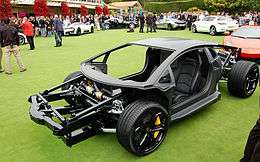
Subframe
A subframe is a distinct structural frame component, to reinforce or complement a particular section of a vehicle's structure. Typically attached to a unibody or a monocoque, the rigid subframe can handle high chassis forces and can transfer them evenly over a wide area of relatively thin sheet metal of a unitized body shell. Subframes are often found at the front or rear end of cars, and are used to attach the suspension to the vehicle. A subframe may also contain the engine and transmission. It is normally of box steel construction, but may be tubular.
Examples of passenger car use include the 1967–1981 GM F platform, the numerous years and models built on the GM X platform (1962), GM's M/L platform vans(Chevrolet Astro/GMC Safari, which included an all-wheel drive variant), and the unibody AMC Pacer that incorporated a front subframe to isolate the passenger compartment from engine, suspension, and steering loads.[20][21]
See also
| Wikimedia Commons has media related to Vehicle chassis. |
References
- ↑ Rajput, R. K. (2007). A textbook of automobile engineering. Laxmi Publications. p. 410. ISBN 9788170089919. Retrieved 28 February 2015.
- ↑ "unibody". Dictionary.com. Retrieved 28 March 2016.
- ↑ "unit body". engineering-dictionary.org. Retrieved 28 March 2016.
- ↑ Visnic, Bill (1 September 2008). "Shift to Unitized Body No Slam Dunk". Wards Auto. Retrieved 28 March 2016.
- 1 2 Genta, Giancarlo; Morello, Lorenzo; Cavallino, Francesco; Filtri, Luigi (2014). The Motor Car Past, Present and Future. Springer. pp. 23–26. ISBN 9789400785519. Retrieved 28 March 2016.
- 1 2 3 4 5 Simanaitis, Dennis (5 October 2011). "From the Carriage Trade to Carbon Fiber All about an automobile's body/chassis". Road and Track. Retrieved 10 August 2016.
- ↑ "Joseph Ledwinka". Hagley Museum and Library. 29 May 2013. Retrieved 10 August 2016.
- ↑ "20 Cars that Changed the Automotive Industry Forever". Magic Online. 13 October 2014. Retrieved 10 August 2016.
- ↑ "The Designs of John Tjaarda Result in the 1936 Lincoln Zephyr". The Old Motor. 27 December 2014. Retrieved 28 March 2016.
- ↑ Consumer Guide Auto Editors (1985). Great cars of the forties. Louis Weber. p. 54. ISBN 9780881762808. Retrieved 28 March 2016.
- ↑ Ted, Tidious (8 July 2014). "Great American Cars Of The Forties – 1941 Nash 600". Retrorambling. Retrieved 28 March 2016.
- ↑ "My Mother's Compact Car: Twenty Years Of Rambler". Automobile Quarterly. 33 (2): 33. Retrieved 28 March 2016.
- 1 2 Narus, Donald J. (2012). Nash, 1939-1954. New Albany Books. p. 27. ISBN 9781467521246. Retrieved 28 March 2016.
- ↑ "Chrysler moves to Unibody (unit-body construction): 1960". allpar.com. Retrieved 28 March 2016.
- ↑ Bruzek, Joe (22 October 2008). "What is unibody construction?". Ask.Cars.com. Retrieved 28 February 2015.
- ↑ Foster, Patrick R. (2014). Jeep: The History of America's Greatest Vehicle. Motorbooks. p. 124. ISBN 9781627882187. Retrieved 28 March 2016.
- ↑ Niedermeyer, Paul (19 January 2012). "Automotive History: An X-Ray Look At GM's X Frame (1957 – 1970)". Curb Side Classic. Retrieved 28 February 2015.
- ↑ "Thread: Mercedes Benz 190SL, the "Teutonic T-bird" is born, 1954...". vwvortex.com. Retrieved 28 February 2015.
- ↑ Ludvigsen, Karl (2010). Colin Chapman: Inside the Innovator. Haynes Publishing. pp. 150–164. ISBN 1-84425-413-5.
- ↑ Burger, Gerry; Hendrickson, Steve (2000). Hot rodder's bible. MBI Publishing. pp. 123–124. ISBN 9780760307670. Retrieved 28 February 2015.
- ↑ "AMC Pacer station wagon". Car and Driver. 22: 24. 1977. Retrieved 28 February 2015.